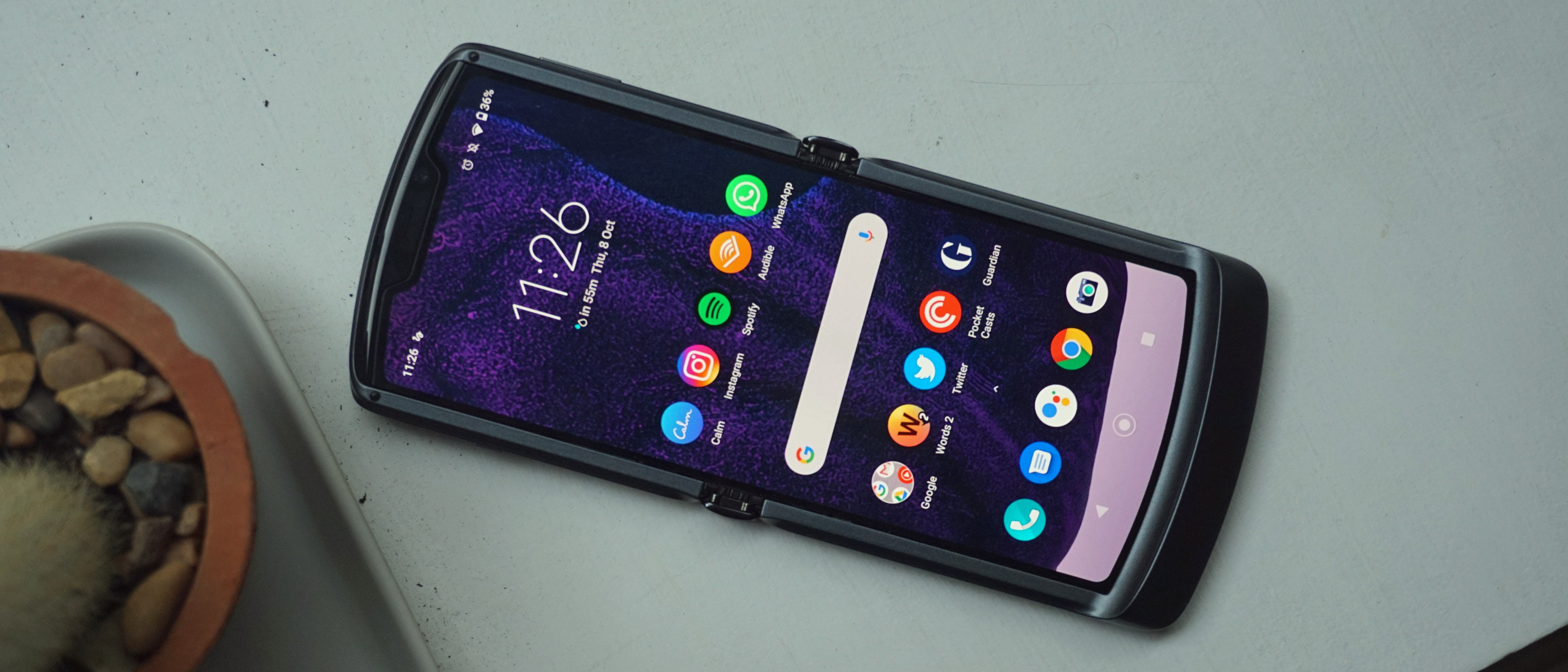TechRadar Verdict
The Motorola Razr 2020 is undeniably better than its predecessor, solving the issues of limited storage and packing in 5G connectivity, while Motorola has tweaked the design to make it sleeker. On the other hand, this is still a restricted foldable phone because it doesn’t offer the best tech or design on the market – and when you’re spending well over $1,000 or £1,000 on a phone, you’re likely to be disappointed with that.
Pros
- +
Exciting design and look
- +
Improved front display
- +
Serious internal upgrades
Cons
- -
Slight creaking noise when unfolding
- -
Mediocre battery life
- -
Very, very expensive
Why you can trust TechRadar
Two-minute review
The Motorola Razr 2020 is an updated version of the company’s first foldable phone, which saw it bring back its iconic 2000s flip phone name and look, but retooled with a folding design.
The original Razr was one of the first widely available folding phones, and less than a year later the company has debuted this new version, addressing a few of the issues with the first device, but mostly sticking with the same design and construction.
The Razr has a clamshell design that allows the phone to be smaller than your average smartphone when folded, but still sport a 6.2-inch main display when unfolded that is a size that can compete with top-end flagships.
Motorola has oddly opted to include a lesser chipset than other/most other/many other top-end phones though, and there are a few areas where Motorola appears to have opted for less premium components.
The Razr is also extraordinarily expensive at $1,400 or £1,400, which is an extremely high price for anyone to pay for any phone, let alone one with less-than-top-end specs.
This new Razr may feature double the storage of its predecessor and a larger front display, and it brings 5G connectivity to the party, but that doesn’t make it a must-buy phone.
If you love the idea of the foldable Razr and are looking for your first folding phone, and if you have sufficiently deep pockets, this may be exactly what you’re looking for. Before you take the plunge, though, we’d recommend that you carefully weigh up this phone’s pros and cons in key areas, and we’ll look at those in detail below.
Motorola Razr 2020 price and release date
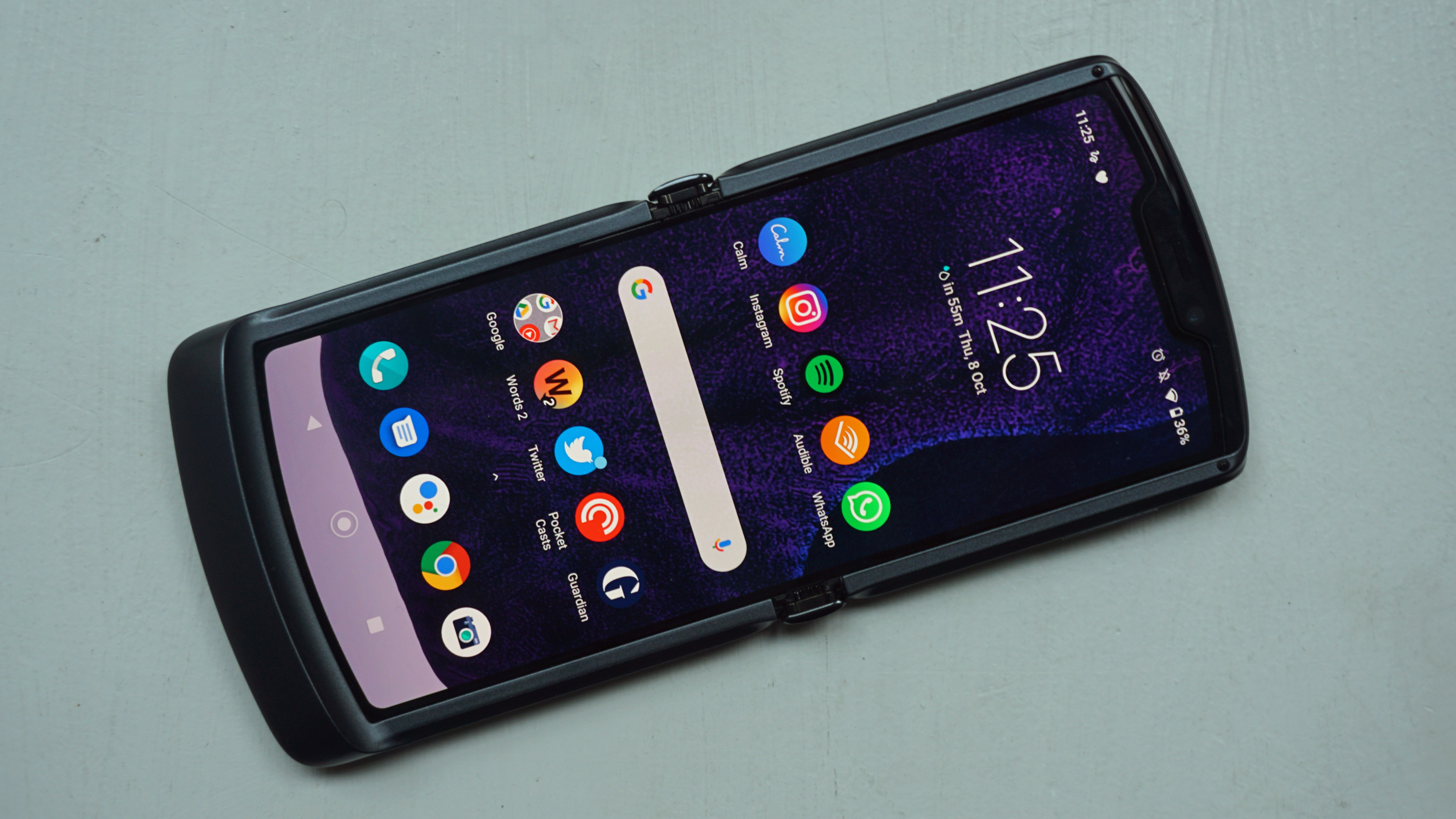
The Motorola Razr 2020 was announced on September 9, 2020, and it came out on October 2 in the US. It's unclear when the clamshell foldable will be released in other regions, but you’re able to pre-order it in the UK now.
Those in Australia are able to buy the Moto Razr 2019, but there’s no sign of the new foldable coming to that market at this time. TechRadar has asked Motorola to confirm if it’s coming to Australia, and we’ll update this review when we know more.
The Razr 2020 comes in three colors: the matte black Polished Graphite, gray-and-black Liquid Mercury, and Blush Gold.
The Motorola Razr 2020 price is $1,399 / £1,399 (around AU$1,900), making it slightly cheaper than its predecessor. In the US, it’s available unlocked at Best Buy, B&H Photo, Amazon.com and Motorola.com, while if you prefer to buy from a carrier you’re limited to either T-Mobile or AT&T.
At the time of writing the Razr 2020 is temporarily available for $200 off at retailers and carriers, while the latter (T-Mobile and AT&T) have special offers that make it even cheaper.
In the UK, where the phone is called the Motorola Razr 5G, you can get it from O2, Vodafone, Tesco, John Lewis, Amazon and Carphone Warehouse, but only in the Polished Graphite finish – the Liquid Mercury and Blush Gold colors are only available from Motorola's website, along with Polished Graphite.
Design
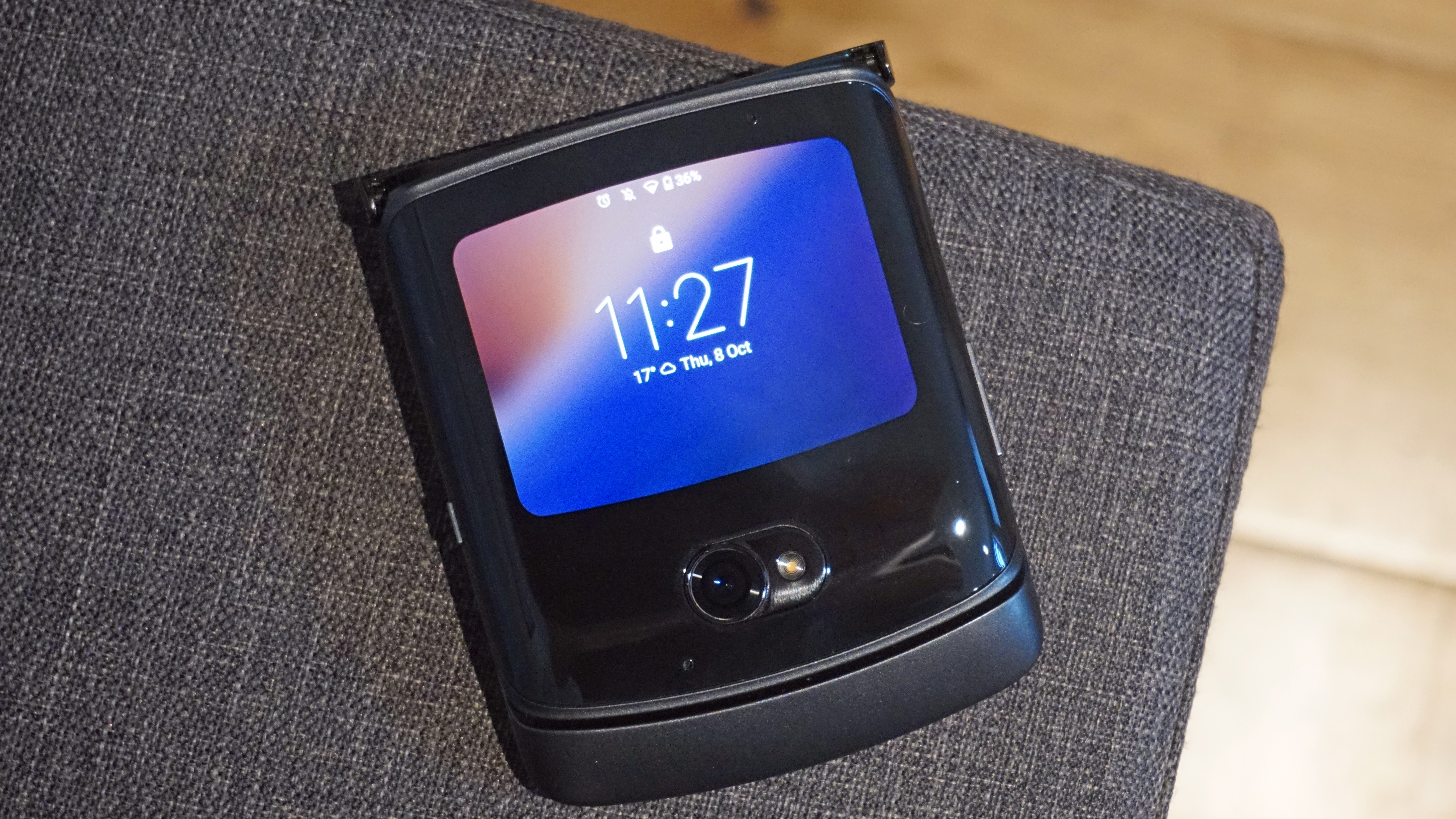
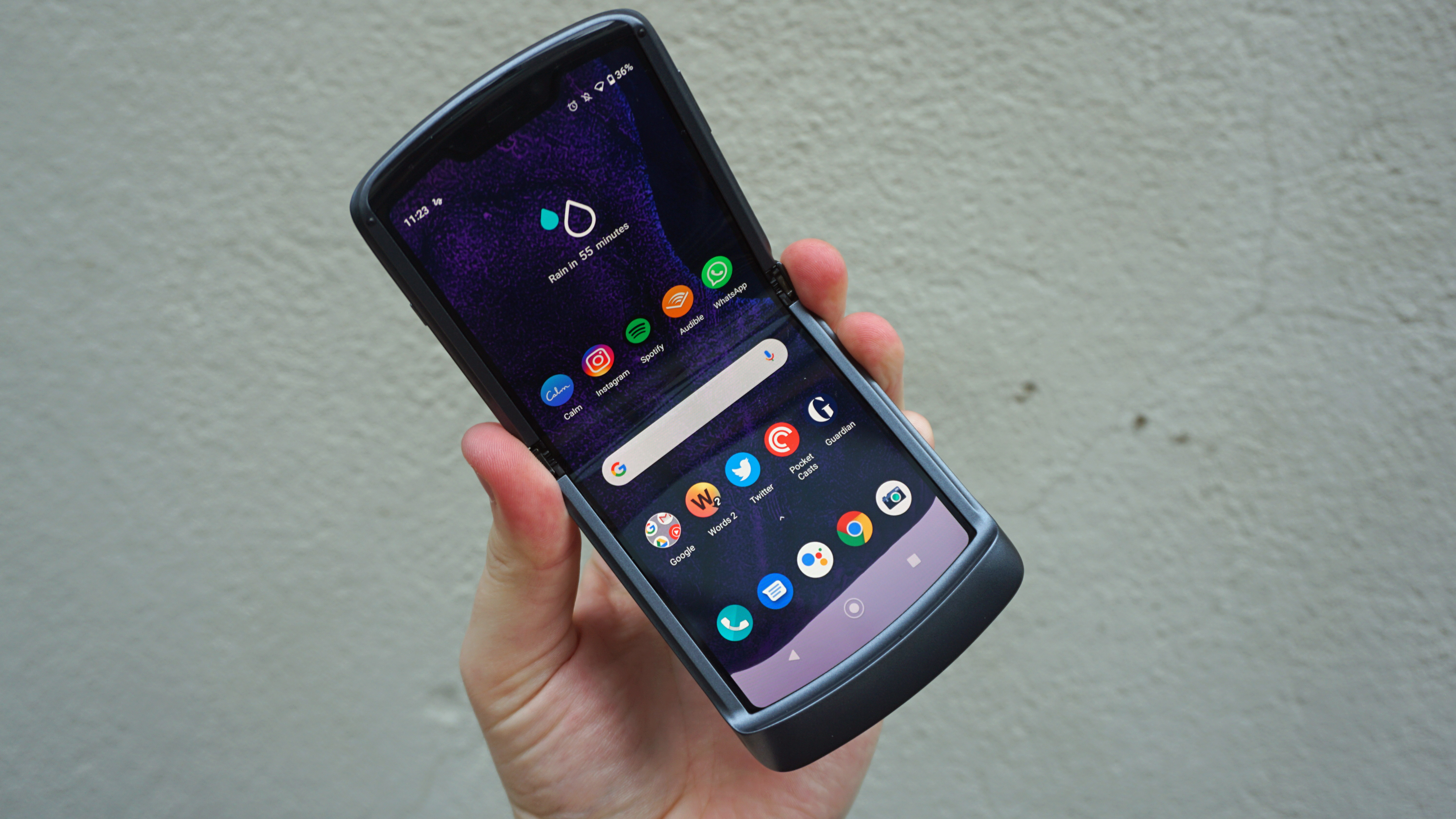
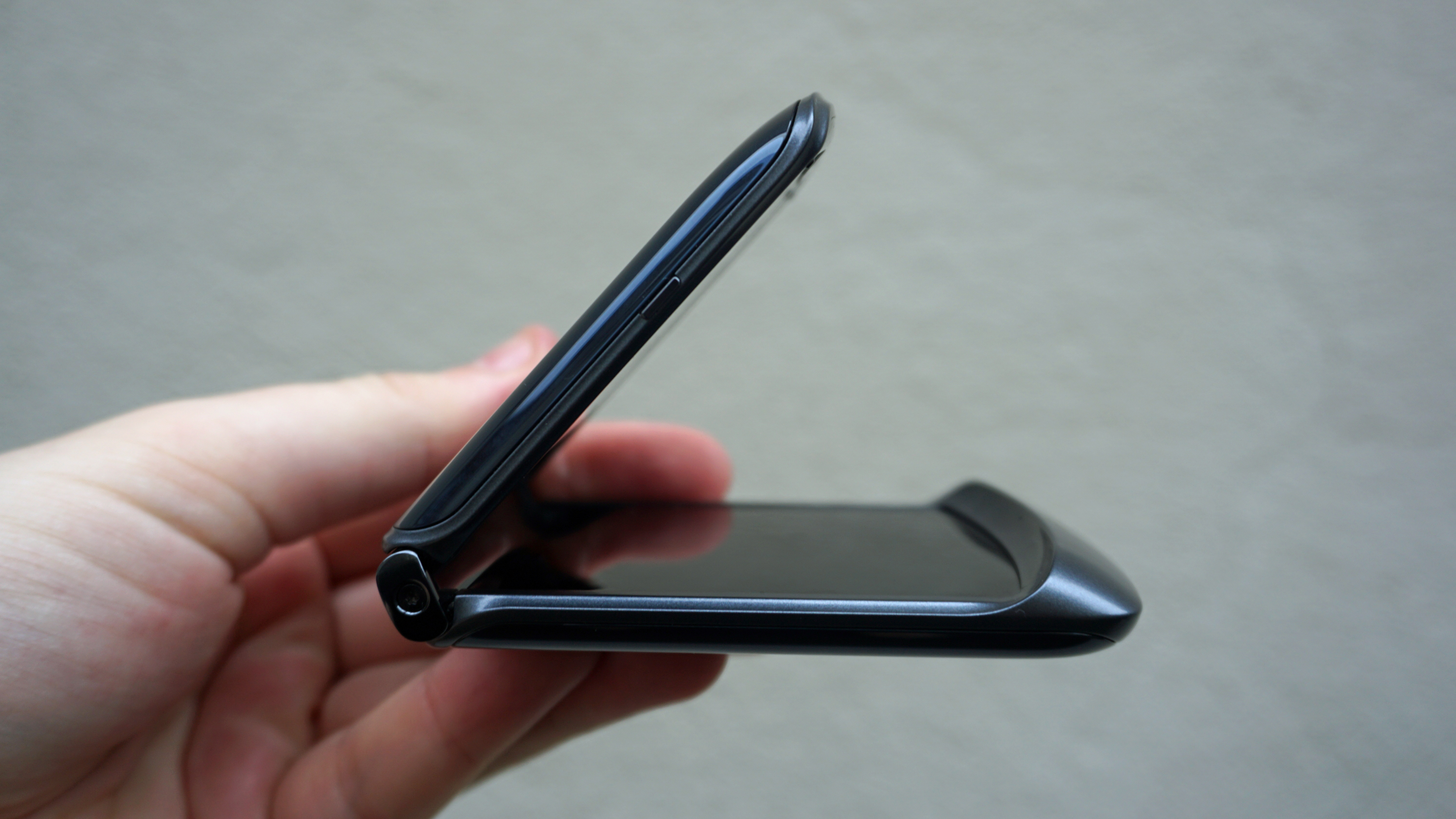
The Razr 2020 looks and functions much like its predecessor – it’s a clamshell foldable that's about the size of a typical smartphone when unfolded, and takes up about half that footprint when folded closed.
That enables it to pull off some neat tricks that typical smartphones can’t, but mostly the Razr's advantage lies in its pocketability, as it’s able to fit into smaller spaces than your average tall and narrow phone.
If you’re looking for a device that can fit in even a shirt pocket, or easily slip into a small handbag, while still offering a full-size smartphone experience, this is it.
The Razr shares this advantage with the Samsung Galaxy Z Flip, although while the latter phone can be opened to any angle between closed and flat, Motorola's handset springs from closed to fully open, and can't really be used between its unfolded and folded states.
That’s a downside we found a little frustrating with the Moto Razr, and it’s one reason you might want to opt for the Samsung instead.
The build quality is another area where the Motorola Razr suffers. It has a glass front and rear (when the phone is closed), and these feel durable, while the hinge on the device works well to unfold the phone, so it’s easy enough to flip the screen open.
However, in our testing time – which only lasted a week – we found the hinge made some noticeable creaking noises. This was also an issue with the original Razr, and while Motorola assures us this isn’t a sign that the phone is broken, it isn’t exactly a noise you’d want to hear when opening or closing such an expensive device.
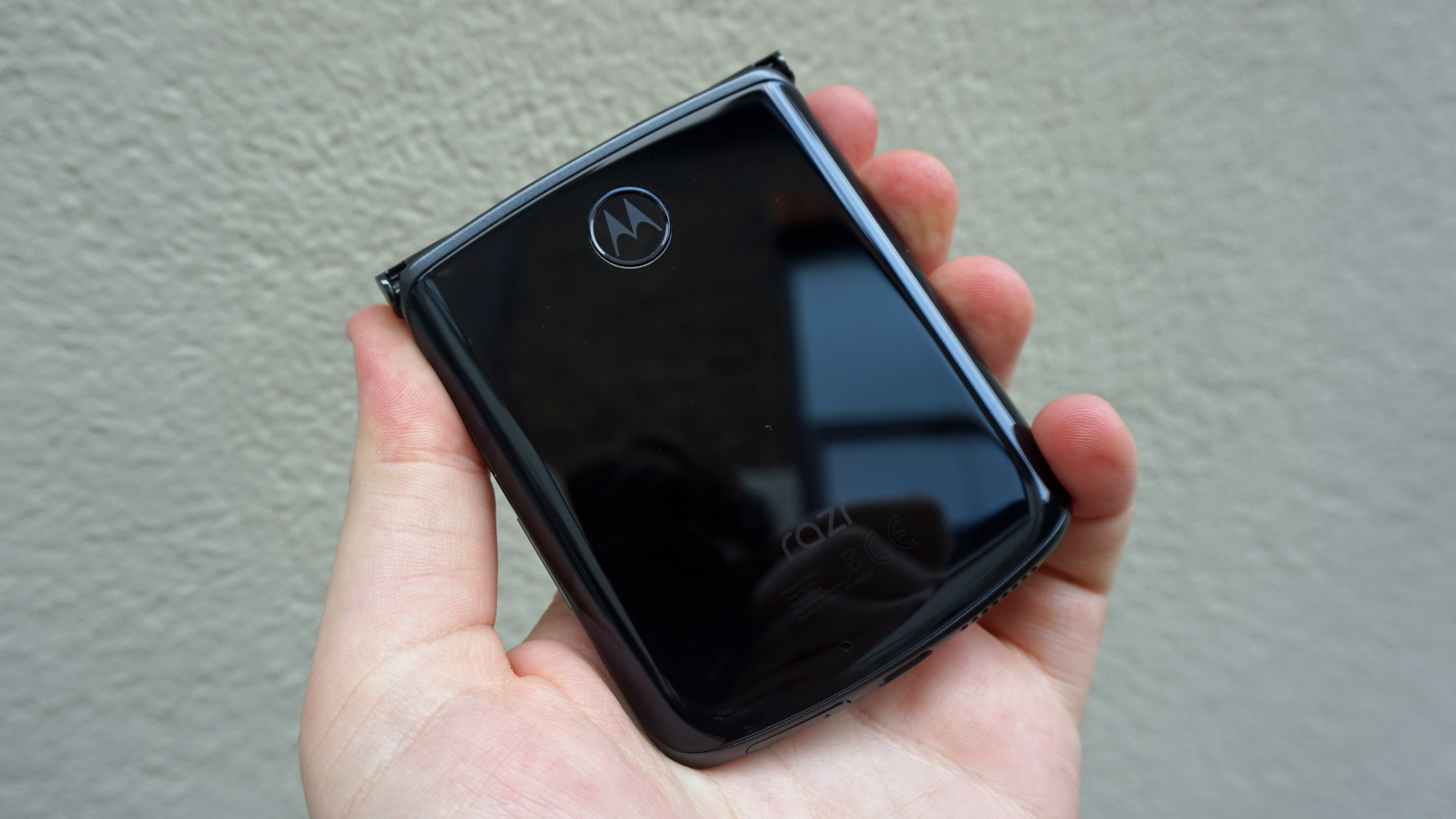
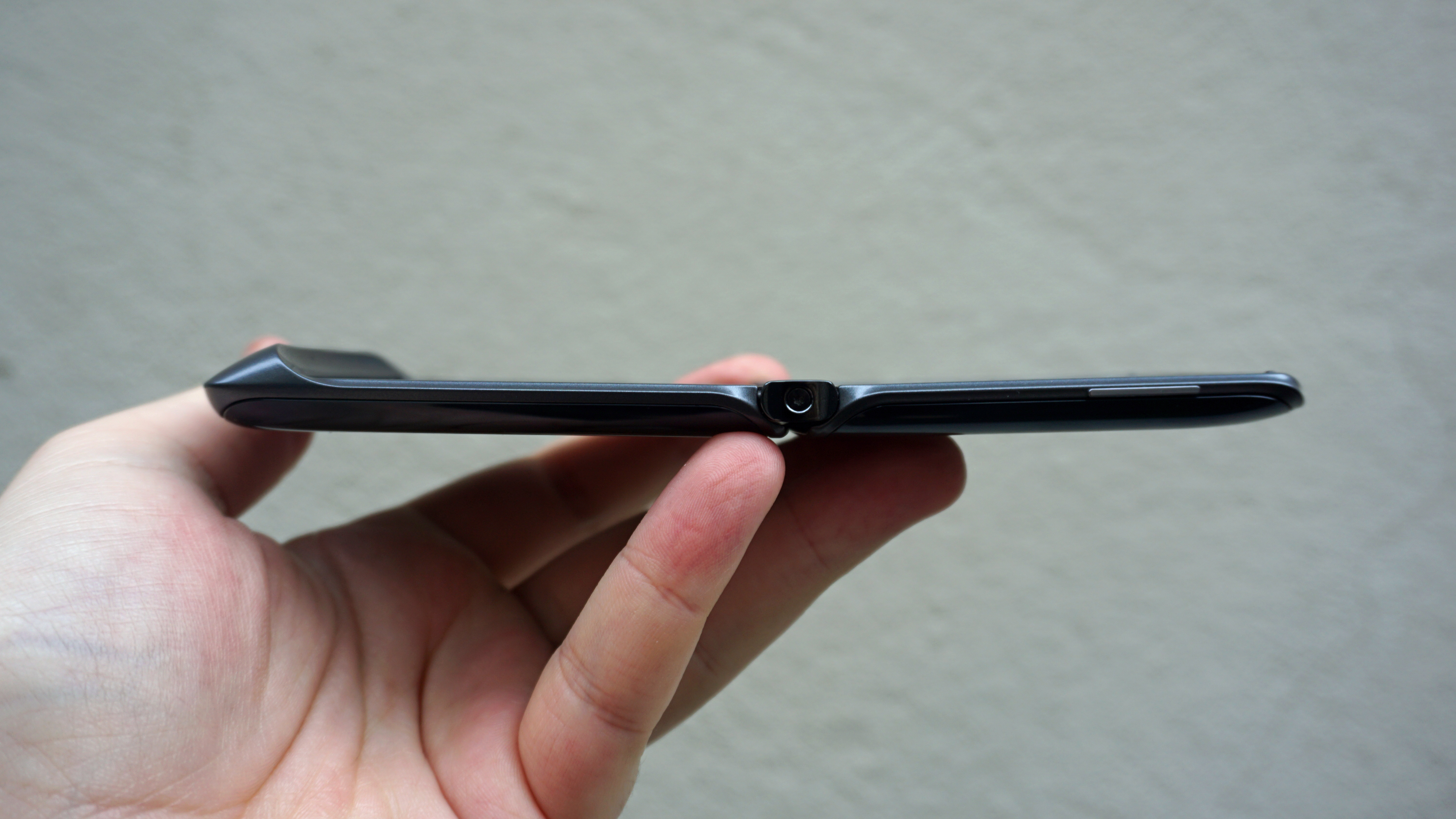
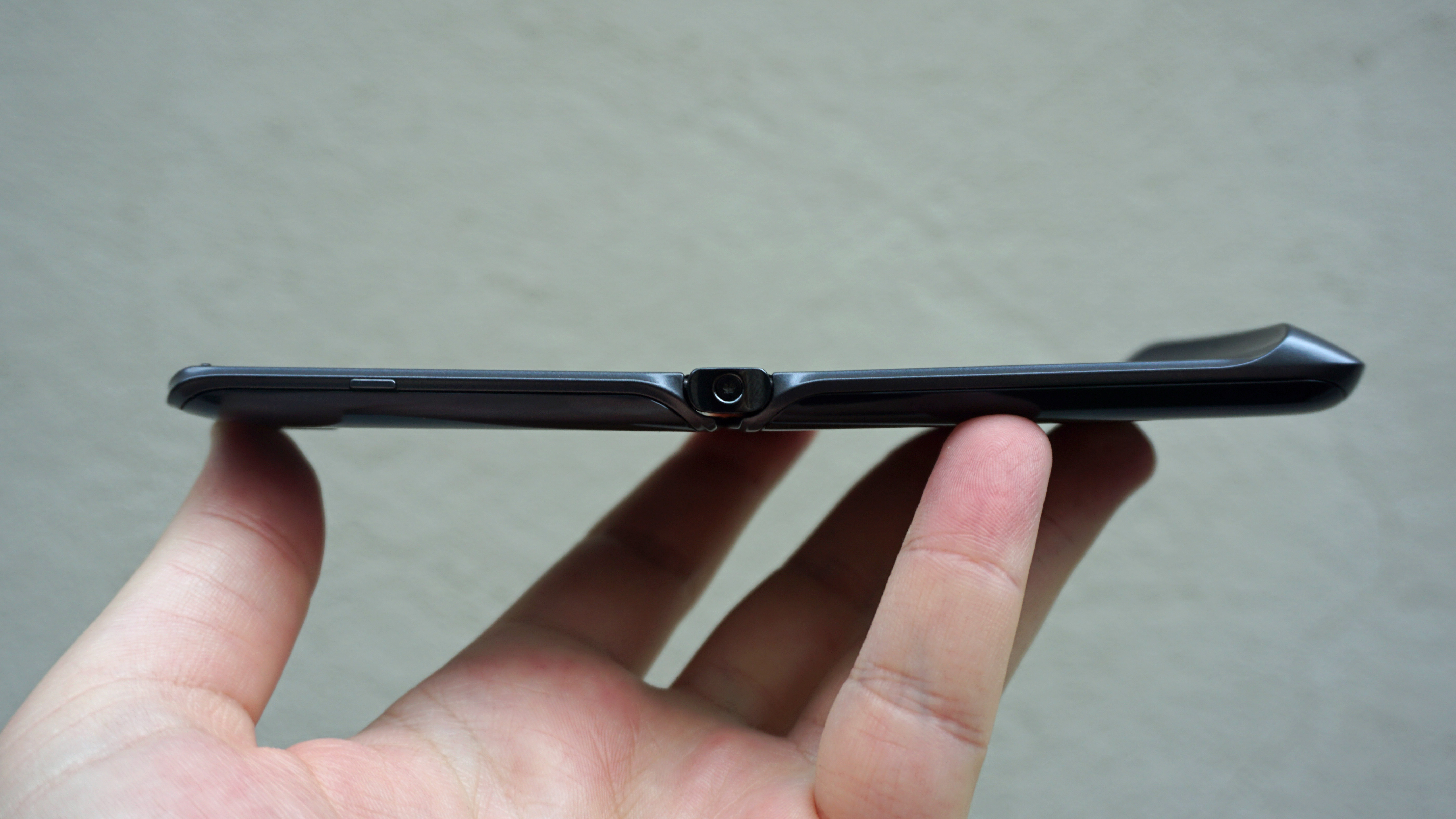
The fingerprint scanner is in an easy-to-reach location on the rear of the phone, making it easy to unlock either the front screen, or the main screen when the phone is unfolded.
An aluminum frame helps the device to feel premium, and the chin at the bottom of the phone is made of metal, adding to the sense that this is a top-end device; that said, there’s something about the Razr 2020 that means it just doesn’t feel as slick as other foldable devices we’ve used.
On the bottom edge of the phone are a USB-C port and speaker, along with the SIM tray, while you’ll find the volume rocker on the right-hand side, with the power button on the left. There’s no 3.5mm headphone jack on the handset.
The phone weighs 192 grams, which is around what you’d expect for a flagship device. We found that meant it was pocketable, which is something you can’t say for some foldable phones like the Samsung Galaxy Z Fold 2 that is much larger even when folded.
Display
There are two displays here to talk about, and we'll start with the core screen that you’ll be using most of the time: the 6.2-inch foldable main display.
The 6.2-inch POLED (plastic OLED, a design that uses a plastic base layer instead of glass, most OLED panels have) main display hasn't changed from the original Razr 2019. That's about as tall as a typical smartphone, but it’s a bit narrower, with an HD Plus resolution (2142 x 876) that's slightly less sharp than the Full HD of other phones, including the Samsung Galaxy Z Flip (2636 x 1080).
You may notice the slight reduction in quality, and that’s a shame for a phone which costs this much money, although once we got used to the display we didn’t really find it an issue. It’s only a 60Hz panel too, so you’re not getting a super-smooth refresh rate, as we’re increasingly seeing on top-end phones this year.
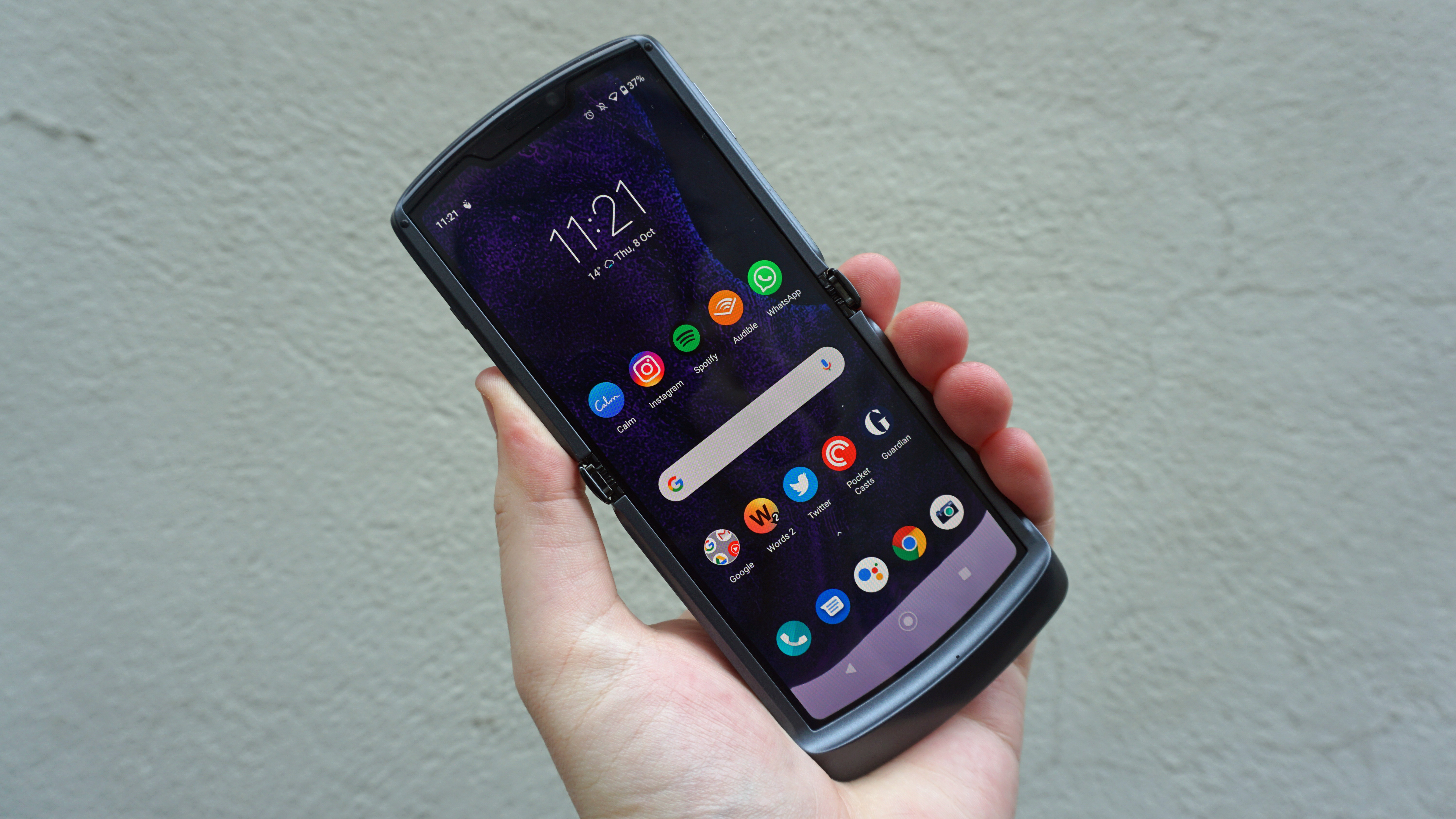
When unfolded, we found the display worked well for typing, tapping and swiping. It mostly feels like a normal phone screen, although you’ll find it has a little give in the middle, where the hinge of the phone is located. There’s a cut-out at the top of the screen that houses the selfie camera and call speaker.
This isn’t the highest-quality foldable screen on the market, and the phone’s design does mean that you’re really just getting a similar display to what you’d find on a regular handset.
Then there’s the front screen, which is designed to allow you to see your notifications, and interact with certain elements of your phone, without unfolding it. On the last-gen Razr this was a 1.1-inch display, but here it’s evolved to become a 2.7-inch screen.
Motorola refers to it as the QuickView display, and that’s an appropriate term, as it’s mostly designed for quick tasks like checking your notifications, responding to the odd message, or selecting songs when you’re playing music.
The resolution is fine, but this isn’t where you’ll want to be watching videos. It’s 800 x 600, but resolution specs don’t mean much on such a small display, and it doesn’t make much difference for the things you’ll be doing on this screen
That said, we didn’t find ourselves using this smaller display that much. It proved useful for checking notifications, but often we’d unfold the phone to reply to a message, both because it’s easier on the larger display, and because some apps don’t work on the QuickView screen.
For example, you can reply to WhatsApp messages on the smaller screen, but you can’t open Google Drive on the front display, so if you want to see a Drive notification in any further detail, and respond, you’ll have to open the main screen.
That didn’t prove to be a problem for us, but it did mean the battery-life savings that Motorola believes the front screen offers were rather negligible, as often we only made brief use of the QuickView display before opening the phone to use the full-size display.
Camera
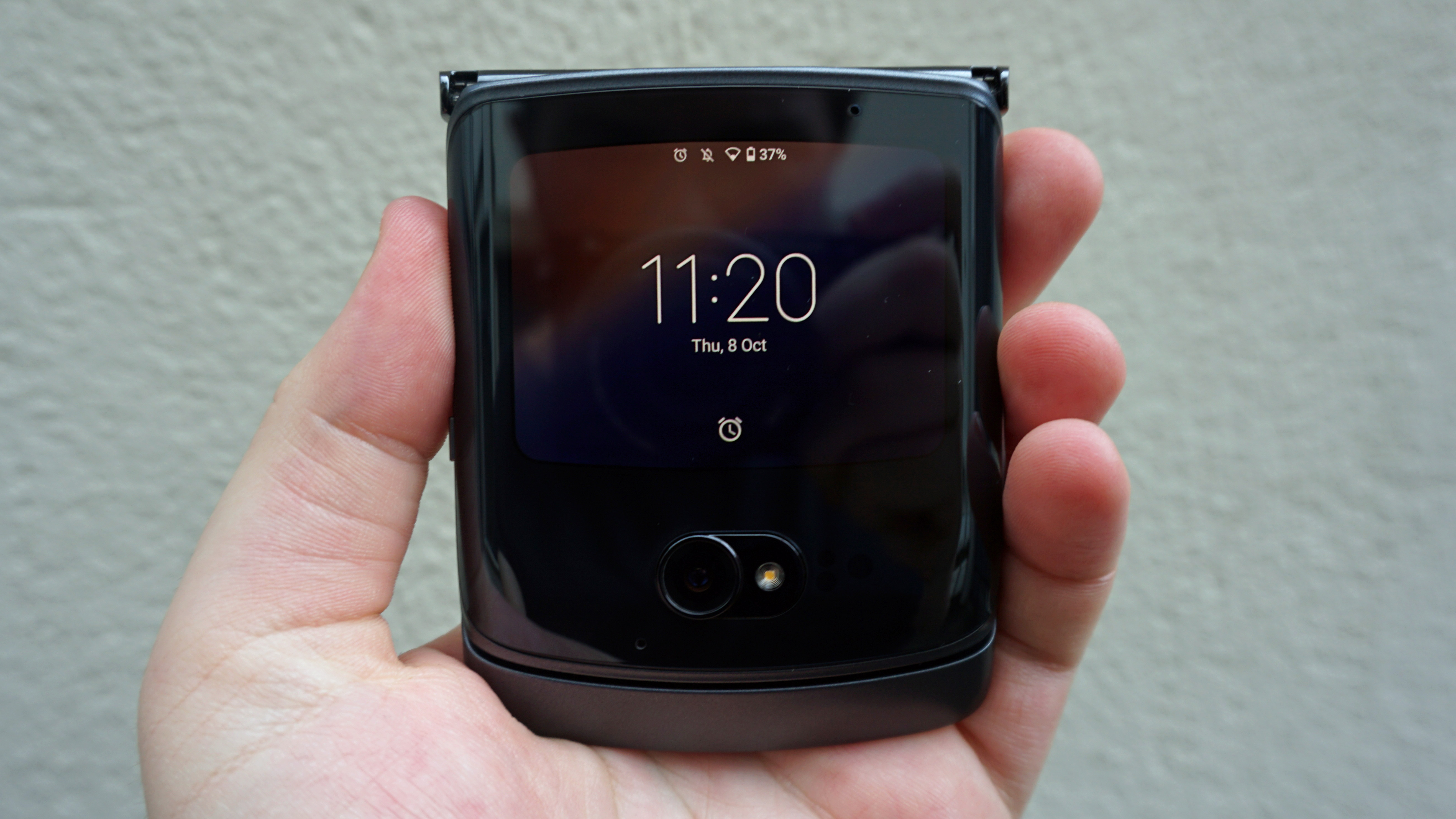
The Motorola Razr 2020 has two cameras, much like normal ones with one on the rear and one at the top of the screen. On the front of the phone when it’s closed is a 48MP shooter, which is a big step up from the 16MP shooter on the first-gen Razr foldable.
Thanks to the clamshell folding format, this can be used to take selfies when the phone is folded shut: the QuickView screen shows a preview of the shot with a tappable shutter button, although you can also use either volume button to take a photo.
While this 48MP camera can be used to take selfies when the phone is shut, it also acts as your main camera when the phone is unfolded, so it’s this camera that we’ll mainly be talking about here.
If you want to make video calls or take selfies using the main screen when the phone is open, you’ll find a 20MP shooter at the top of the screen, and it will work well for those tasks.
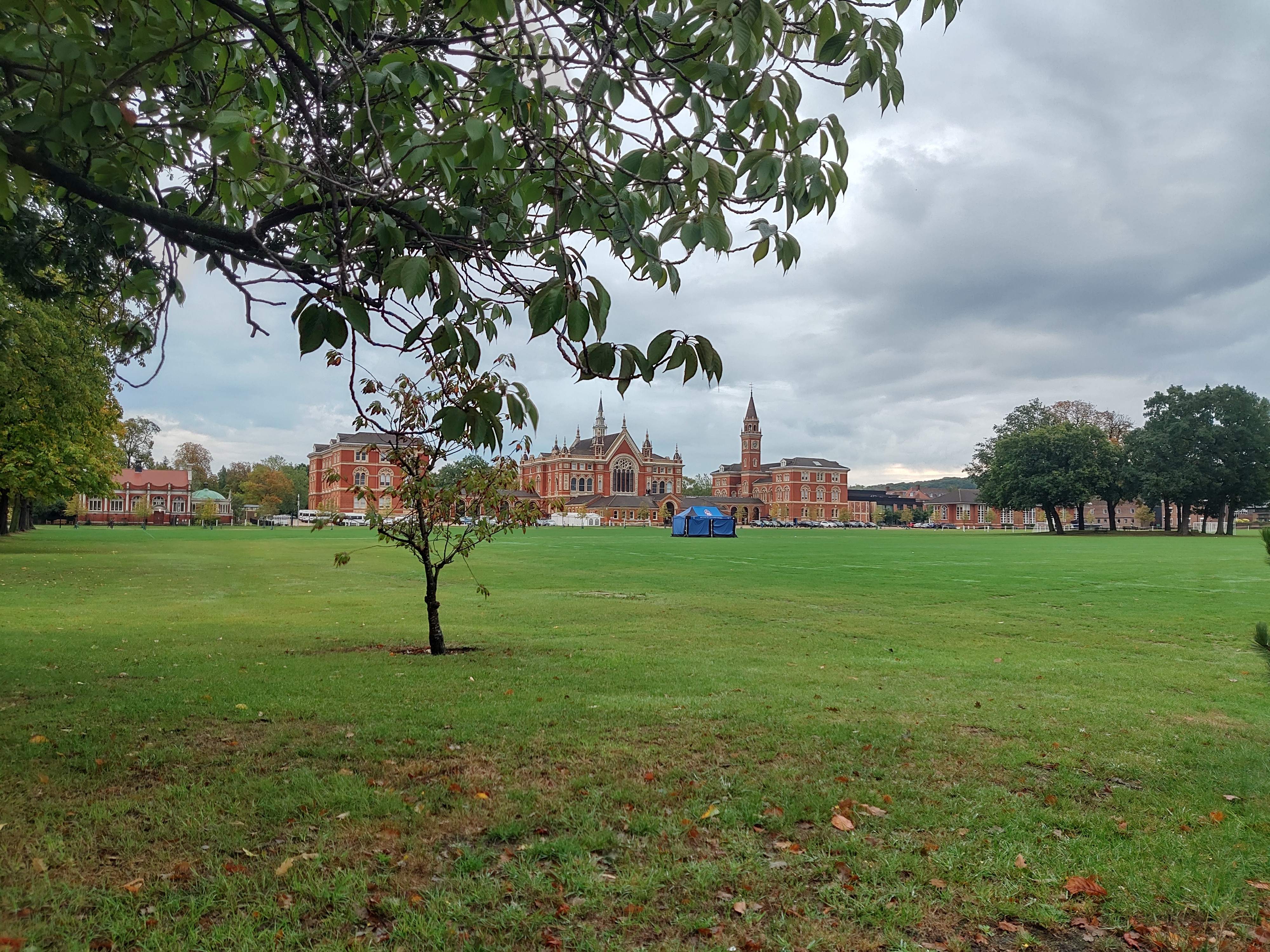


The Motorola Razr’s main camera is capable of taking good-quality shots, but it doesn’t have many of the photography features you’d find on even most mid-range phones, which again is disappointing on a phone this expensive.
For example, you’ve only got the one camera, so there’s no option to switch to an ultra-wide or telephoto lens for different shooting scenarios.
The camera produces nice-looking images with true-to-life colors and plenty of detail, but if you like to get creative with your smartphone photography you’ll likely be disappointed by the lack of options here.
Disclaimer: We've got a limited amount of photo samples here owing to a cloud backup issue. We hope to include further camera samples soon when we're able to use the phone again.
Specs and performance
First things first: the specs of the Motorola Razr aren’t as high as you might be expecting, especially given the price. In fact, the company has opted for a lower-end chipset than many would expect in a phone of this type, although we found it to perform well in everyday use.

Weight: 193g
Main display size: 6.2-inch
Resolution: HD+ (2142 x 876)
Outer display size: 2.7-inch
Resolution: SVGA (800 x 600)
Chipset: Snapdragon 765G
RAM: 8GB
Storage: 256GB
OS: Android 10
Outer camera: 48MP
Inner camera: 20MP
Battery: 2,800mAh
It’s the Qualcomm Snapdragon 765G, which is a slightly upgraded chip to the one in the original foldable Razr so it can connect to 5G networks, but it still isn’t a top-end piece of hardware.
This is paired with 8GB of RAM – the last-gen Razr only had 6GB – which likely brings improvements performance-wise. All apps and games loaded reasonably briskly, and we found the phone had enough power for pretty much everything we wanted to do.
The odd occasion we found ourselves waiting for a game to load a little longer than you’d expect on a flagship phone, but it never particularly irritated us. On paper this isn’t a powerhouse device, but you won’t always notice that in everyday use.
You get 256GB of internal storage, which is double that of the last-gen Razr, and it’s a welcome upgrade if you like to load up your phone with apps, games and other media.
The other key upgrade over the original folding Razr is that the 2020 model includes 5G connectivity. Most models of the new Razr only work on sub-6 5G networks, although there’s also a Verizon-exclusive version that works with the carrier’s sub-6 and mmWave frequencies.
The Motorola Razr is running Android 10 software, and it looks like you would expect a Motorola phone to. The company has its own look to its phone’s user interface, and that makes a return here - it looks good, and there’s little bloatware included on the phone.
We’ve yet to hear when the company will be updating the software to Android 11.
Motorola’s customizations include Moto Actions, the fan-favorite gestures that enable you to quickly launch certain features – for example double-chopping to turn the flashlight on and off, and twisting your wrist to open the camera app.
Battery life
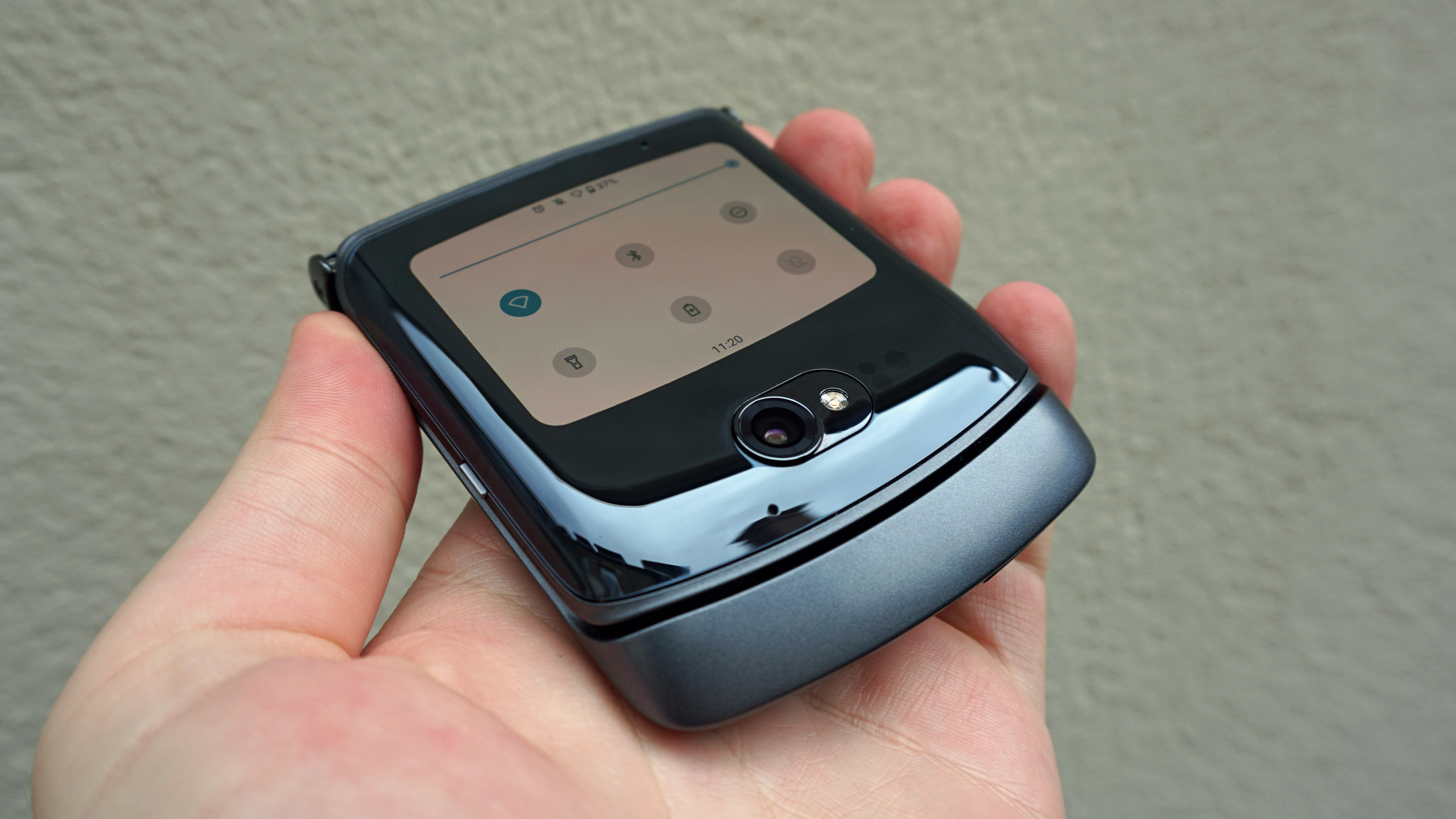
The Motorola Razr 2020’s battery life is better than the last-gen phone’s, but this still isn’t a phone that will impress you with its longevity from a full charge – we often found ourselves recharging the device before the end of the day.
The battery is 2,800mAh, and considering this is powering two displays that isn’t a very large battery at all. Many flagship phones feature 4,000mAh batteries and higher and still struggle to last a full day.
On a few days we found the phone would be dying on us by 8pm or 9pm, and had to reach for the charger in order to make it to bedtime.
Motorola presumably believes most people will be using the outer display, which is less of a drain on the battery, more that we did – as we’ve mentioned, we didn’t use it that much, and tended to rely on the main screen.
The Razr does at least support 15W fast charging, which we found charged the device from empty to 37% in half an hour. This isn’t the best fast-charging tech we’ve seen, but it’s adequate if you need to top up your phone quickly.
There’s no wireless charging here, and we suspect that’s because the design of the phone would have made it difficult to implement.
Should I buy the Motorola Razr 2020?

Buy it if…
You’re desperate to try a foldable phone
Foldable phones are exciting, there’s no denying it. If you like Motorola’s take on the form factor – and you don’t mind paying for it – and you’re willing to forgive it for its few missteps, then it may be a great choice.
You need a device that can act small
There aren’t many truly small phones on the market right now, and if you’re after all the power of a full-size smartphone in a device that only takes up half the space of your average big-screen phone, you’ll like the new Razr.
You love the look of this device
The biggest reason to buy the Razr is because of its unique look. If you want the nostalgia factor of one of the best smartphones ever made – the original clamshell Razr line – then you’ll probably love this phone.
Don’t buy it if…
You’re not convinced by foldable phones
The creaky screen is here again on the Motorola Razr 2020. The company insists that this isn’t a flaw, and that it’s part and parcel of having a foldable display, but if you already have doubts about folding phones the Razr is unlikely to persuade you otherwise.
You need long battery life
We found that the Motorola Razr 2020 would often need a top-up to see us through a full day. If you need a phone that offers dependable battery life, the Razr isn’t for you.
You want a cheap phone
The Motorola Razr 2020 is one of the most expensive phones around, and the price is particularly eye-watering given the modest internal specs. If you’re looking for an affordable handset – or even just a realistically priced one – you’ll need to look elsewhere.
First reviewed: October 2020
James is the Editor-in-Chief at Android Police. Previously, he was Senior Phones Editor for TechRadar, and he has covered smartphones and the mobile space for the best part of a decade bringing you news on all the big announcements from top manufacturers making mobile phones and other portable gadgets. James is often testing out and reviewing the latest and greatest mobile phones, smartwatches, tablets, virtual reality headsets, fitness trackers and more. He once fell over.
